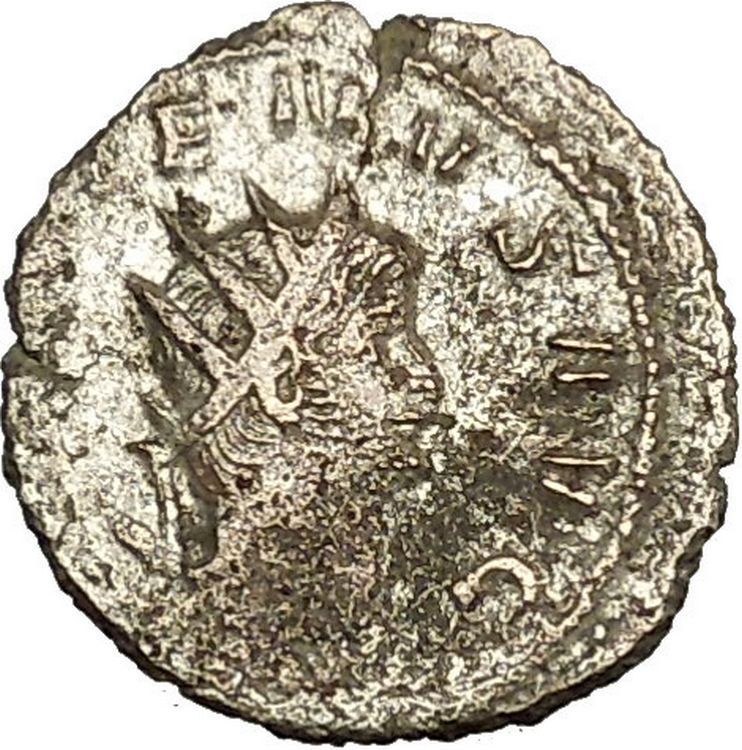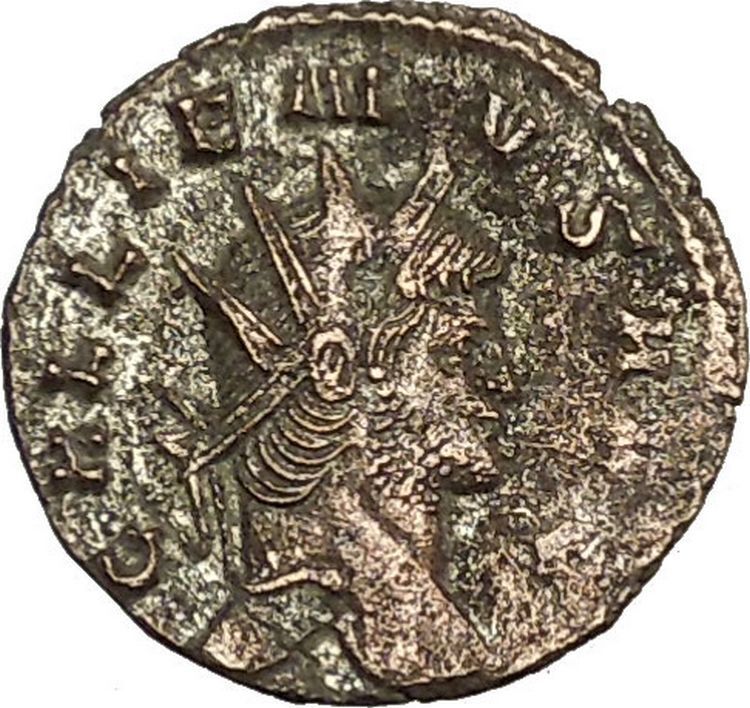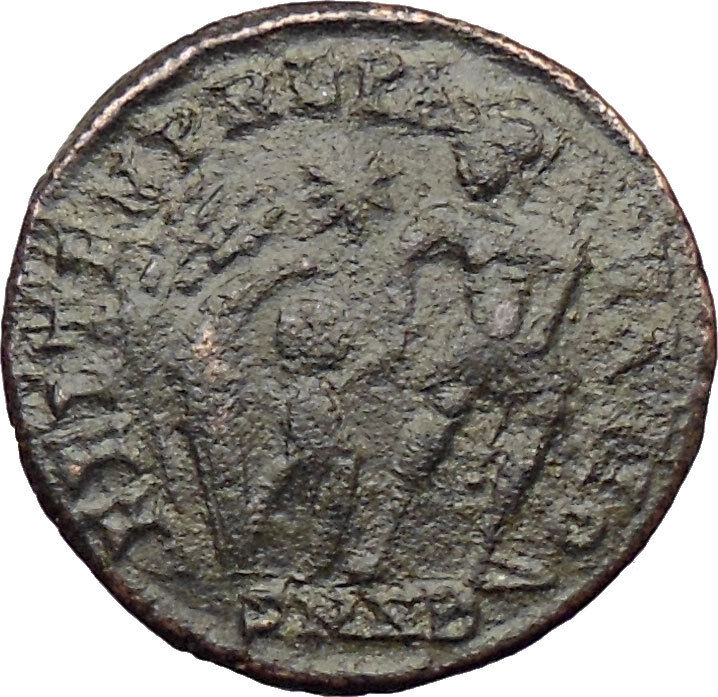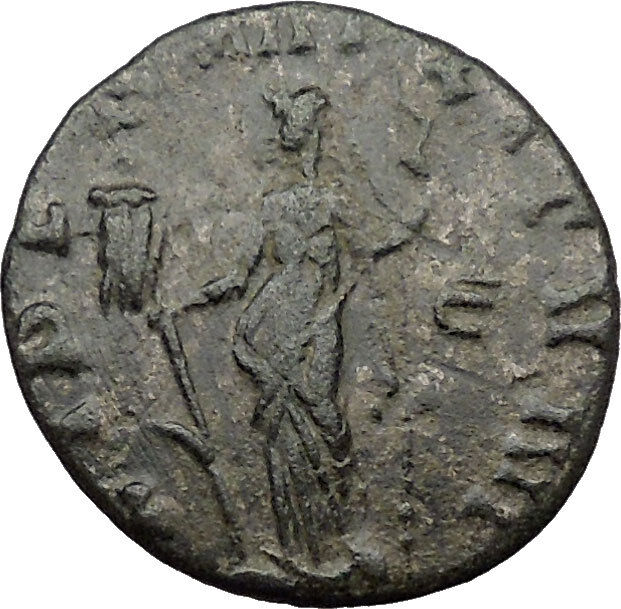|
Valerian II – Roman Caesar: 256-258 A.D. –
Silver Antoninianus 21mm (3.29 grams) Struck circa 256-258 A.D.
Reference: RIC 46, C 24
VALERIANVSNOBILCAES – Radiate, draped bust right.
FIDESMILITVM – Legionary eagle, standard on either side
You are bidding on the exact
item pictured, provided with a Certificate of Authenticity and Lifetime
Guarantee of Authenticity.
An aquila, or eagle,
was a prominent symbol used in ancient Rome, especially as the
standard
of a
Roman legion
. A
legionary
known as an
aquilifer
, or eagle-bearer, carried this
standard. Each legion carried one eagle.

Roman ornament with an aquila (100–200 AD) from the
Cleveland Museum of Art
.
The eagle was extremely important to the Roman military, beyond merely being
a symbol of a legion. A lost standard was considered an extremely grave
occurrence, and the Roman military often went to great lengths to both protect a
standard and to recover it if lost; for example, see the aftermath of the
Battle of the Teutoburg Forest
, where the
Romans spent decades attempting to recover the lost standards of three legions.
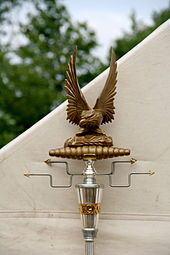
A modern reconstruction of an aquila
History
The signa militaria were the Roman military
ensigns
or
standards
. The most ancient standard employed
by the Romans is said to have been a handful (manipulus) of straw fixed
to the top of a spear or pole. Hence the company of soldiers belonging to it was
called a
maniple
. The bundle of
hay
or fern
was soon succeeded by the figures of
animals, of which
Pliny the Elder
(H.N. x.16) enumerates
five: the eagle
, the
wolf
, the ox with the man’s head, the
horse
, and the
boar
. In the second consulship of
Gaius Marius
(104 BC) the four quadrupeds were
laid aside as standards, the eagle (Aquila) alone being retained. It was
made of silver
, or
bronze
, with outstretched wings, but was
probably of a relatively small size, since a standard-bearer (signifer)
under Julius Caesar
is said in circumstances of
danger to have wrenched the eagle from its staff and concealed it in the folds
of his girdle.Under the later emperors the eagle was carried, as it had been for
many centuries, with the legion, a legion being on that account sometimes called
aquila (Hirt. Bell. Hisp. 30). Each
cohort
had for its own ensign the
serpent
or
dragon
, which was woven on a square piece of
cloth textilis anguis, elevated on a
gilt
staff, to which a cross-bar was adapted
for the purpose, and carried by the draconarius.
Another figure used in the standards was a ball (orb), supposed to have been
emblematic of the dominion of Rome over the world; and for the same reason a
bronze figure of
Victoria
was sometimes fixed at the top of the
staff, as we see it sculptured, together with small statues of Mars, on the
Column of Trajan
and the
Arch of Constantine
. Under the eagle or other
emblem was often placed a head of the reigning emperor, which was to the army
the object of idolatrous adoration.[9]
The name of the emperor, or of him who was acknowledged as emperor, was
sometimes inscribed in the same situation. The pole used to carry the eagle had
at its lower extremity an iron point (cuspis) to fix it in the ground, and to
enable the aquilifer in case of need to repel an attack.
The minor divisions of a cohort, called centuries, had also each an ensign,
inscribed with the number both of the cohort and of the century. This, together
with the diversities of the crests worn by the centurions, enabled each soldier
to take his place with ease.

Denarius
minted by
Mark Antony
to pay his legions. On
the reverse, the aquila of his
Third legion
.
In the
Arch of Constantine
at Rome there are four
sculptured panels near the top which exhibit a great number of standards and
illustrate some of the forms here described. The first panel represents Trajan
giving a king to the Parthians: seven standards are held by the soldiers. The
second, containing five standards, represents the performance of the sacrifice
called
suovetaurilia
.
When Constantine embraced Christianity, a figure or emblem of Christ, woven
in gold upon purple cloth, was substituted for the head of the emperor. This
richly ornamented standard was called
labarum
. The labarum is still used today by
the
Orthodox Church
in the Sunday service. The
entry procession of the chalice whose contents will soon become holy communion
is modeled after the procession of the standards of the Roman army.

Eagle and weapons from an
Augustan-era
funerary monument,
probably that of
Messalla
(Prado,
Madrid
)
Even after the adoption of Christianity as the Roman Empire’s religion, the
Aquila eagle continued to be used as a symbol. During the reign of
Eastern Roman Emperor
Isaac I Komnenos
, the single-headed eagle was
modified to
double-headed
to symbolise the Empire’s
dominance over
East and West
.
Since the movements of a body of troops and of every portion of it were
regulated by the standards, all the evolutions, acts, and incidents of the Roman
army were expressed by phrases derived from this circumstance. Thus signa
inferre meant to advance,[15]
referre to retreat, and convertere to face about; efferre,
or castris vellere, to march out of the camp; ad signa convenire,
to re-assemble. Notwithstanding some obscurity in the use of terms, it appears
that, whilst the standard of the legion was properly called aquila, those
of the cohorts were in a special sense of the term called signa, their
bearers being signiferi, and that those of the manipuli or smaller
divisions of the cohort were denominated vexilla, their bearers being
vexillarii. Also, those who fought in the first ranks of the legion before
the standards of the legion and cohorts were called antesignani.
In military stratagems it was sometimes necessary to conceal the standards.
Although the Romans commonly considered it a point of honour to preserve their
standards, in some cases of extreme danger the leader himself threw them among
the ranks of the enemy in order to divert their attention or to animate his own
soldiers. A wounded or dying standard-bearer delivered it, if possible, into the
hands of his general, from whom he had received it signis acceptis.
Lost Aquilae
- Battles where the Aquilae were lost, units that lost the Aquilae and the
fate of the Aquilae:
- 53 BC –
Battle of Carrhae
. Crassus
Legio X
(returned).
- 40 BC – defeat of
Decidius Saxa
at
Cilicia
(returned).
- 36 BC – defeat of
Mark Antony
(returned).
- 19 BC –
Cantabrian Wars
at Hispania.
Legio I Germanica
(thought to have been
lost, and stripped of its title “Augusta”).
- 9 AD –
Battle of the Teutoburg Forest
.
Legio XVII
,
Legio XVIII
, and
Legio XIX
(all recaptured).
- 66 –
Great Jewish Revolt
.
Legio XII Fulminata
(fate uncertain).
- 87 –
Domitian’s Dacian War
.
Legio V Alaudae
(fate uncertain).
- 132 –
Bar Kochva Revolt
.
Legio XXII Deiotariana
(fate
uncertain).
- 161 – Parthians overrun a legion commanded by Severianus at Elegeia
in Armenia, possibly the
Ninth Legion
.[23]
Modern imagery
-
Reconstruction of aquila on Roman vexilloid
-
Aquila clutching fasces, a symbol in Italy during the Fascist
period
-
Aquilaa on the
coat of arms of Romania
Standards

Roman military standards. The standards with discs, or signa
(first three on left) belong to centuriae of the
legion (the image does not show the heads of the standards – whether
spear-head or wreathed-palm). Note (second from right) the
legion’s
aquila
. The standard on the
extreme right probably portrays the
She-wolf
(lupa) which fed
Romulus
, the legendary founder of
Rome. (This was the emblem of
Legio VI Ferrata
, a legion then
based in
Judaea
, a detachment of which is
known to have fought in Dacia). Detail from Trajan’s Column, Rome

Modern reenactors parade with replicas of various legionary
standards. From left to right: signum (spear-head type), with
four discs; signum (wreathed-palm type), with six discs;
imago of ruling emperor; legionary aquila; vexillum
of commander (legatus) of
Legio XXX Ulpia Victrix
, with
embroidered name and emblem (Capricorn) of legion
Each tactical unit in the imperial army, from centuria upwards, had
its own standard. This consisted of a pole with a variety of adornments that was
borne by dedicated standard-bearers who normally held the rank of duplicarius.
Military standards had the practical use of communicating to unit members where
the main body of the unit was situated, so that they would not be separated, in
the same way that modern tour-group guides use umbrellas or flags. But military
standards were also invested with a mystical quality, representing the divine
spirit (genius) of the unit and were revered as such (soldiers frequently
prayed before their standards). The loss of a unit’s standard to the enemy was
considered a terrible stain on the unit’s honour, which could only be fully
expunged by its recovery.
The standard of a centuria was known as a signum, which was
borne by the unit’s signifer. It consisted of a pole topped by either an
open palm of a human hand or by a spear-head. The open palm, it has been
suggested, originated as a symbol of the
maniple
(manipulus = “handful”), the
smallest tactical unit in the
Roman army of the mid-Republic
. The poles were
adorned with two to six silver discs (the significance of which is uncertain).
In addition, the pole would be adorned by a variety of cross-pieces (including,
at bottom, a crescent-moon symbol and a tassel). The standard would also
normally sport a cross-bar with tassels.
The standard of a Praetorian cohort or an auxiliary cohort or ala was
known as a vexillum
or banner. This was a square flag,
normally red in colour, hanging from a crossbar on the top of the pole. Stitched
on the flag would be the name of the unit and/or an image of a god. An exemplar
found in Egypt bears an image of the goddess Victory on a red background. The
vexillum was borne by a vexillarius. A legionary detachment (vexillatio)
would also have its own vexillum. Finally, a vexillum
traditionally marked the commander’s position on the battlefield.[194]
The exception to the red colour appears to have been the Praetorian Guard, whose
vexilla, similar to their clothing, favoured a blue background.
From the time of
Marius
(consul 107 BC), the standard of all
legions was the
aquila
(“eagle”). The pole was surmounted
by a sculpted eagle of solid gold, or at least gold-plated silver, carrying
thunderbolts in its claws (representing
Jupiter
, the highest Roman god. Otherwise the
pole was unadorned. No exemplar of a legionary eagle has ever been found
(doubtless because any found in later centuries were melted down for their gold
content). The eagle was borne by the aquilifer, the legion’s most senior
standard-bearer. So important were legionary eagles as symbols of Roman military
prestige and power, that the imperial government would go to extraordinary
lengths to recover those captured by the enemy. This would include launching
full-scale invasions of the enemy’s territory, sometimes decades after the
eagles had been lost e.g. the expedition in 28 BC by
Marcus Licinius Crassus
against
Genucla
(Isaccea, near modern
Tulcea
, Rom., in the Danube delta region), a
fortress of the Getae
, to recover standards lost 33 years
earlier by
Gaius Antonius
, an earlier
proconsul
of
Macedonia
. Or the campaigns of AD 14-17 to
recover the three eagles lost by
Varus
in AD 6 in the
Teutoburg Forest
.
Under Augustus, it became the practice for legions to carry portraits (imagines)
of the ruling emperor and his immediate family members. An imago was
usually a bronze bust carried on top of a pole like a standard by an
imaginifer.
From around the time of Hadrian (r. 117-38), some auxiliary alae
adopted the dragon-standard (draco) commonly carried by Sarmatian cavalry
squadrons. This was a long cloth wind-sock attached to an ornate sculpture of an
open dragon’s mouth. When the bearer (draconarius) was galloping, it
would make a strong hissing-sound.
Decorations
The Roman army awarded a variety of individual decorations (dona) for
valour to its legionaries. Hasta pura was a miniature spear; phalerae
were large medal-like bronze or silver discs worn on the cuirass; armillae
were bracelets worn on the wrist; and
torques were worn round the neck, or on the cuirass. The highest
awards were the coronae (“crowns”), of which the most prestigious was the
corona civica, a crown made oak-leaves awarded for saving the life of a
fellow Roman citizen in battle. The most valuable award was the corona
muralis, a crown made of gold awarded to the first man to scale an enemy
rampart. This was awarded rarely, as such a man hardly ever survived.
There is no evidence that auxiliary common soldiers received individual
decorations like legionaries, although auxiliary officers did. Instead, the
whole regiment was honoured by a title reflecting the type of award e.g.
torquata (“awarded a torque”) or armillata (“awarded bracelets”).
Some regiments would, in the course of time, accumulate a long list of titles
and decorations e.g. cohors I Brittonum Ulpia torquata pia fidelis c.R..
Publius Licinius Cornelius Valerianus (d. 257 or 258), also known as
Valerian II, was the eldest son of
Roman
Emperor
Gallienus
and
Augusta
Cornelia Salonina
who was of
Greek
origin
and grandson of the Emperor
Valerian I
who was of a noble and traditional senatorial family.
Shortly after his acclamation as Emperor (Augustus) Valerian made Gallienus
his co-Emperor and his grandson, Valerian, Caesar, in 256. (For a discussion of
the dynastic politics that motivated this process see the related article on
Saloninus
).
The young Caesar was then established in
Sirmium
to represent the Licinius family in the government of the troubled Illyrian
provinces while Gallienus transferred his attentions to Germany to deal with
barbarian incursions into Gaul. Because of his youth (he was probably no more
than fifteen at the time) Valerian was put under the guardianship of
Ingenuus
who seems to have held an extraordinary command as governor of the Illyrian
provinces – i.e. Upper and Lower
Pannonia
and Upper and Lower Moesia
.
It is reported that Salonina was not happy with this arrangement.
Although she could not publicly dispute the decisions of Valerian, the pater
patriae which had been formally agreed by her husband, Gallienus, she
suspected Ingenuus’s motives and asked an officer called Valentinus, otherwise
unknown, to keep an eye on him. Despite this precaution, Valerian died in
late-257-early 258 in circumstances sufficiently suspicious for Gallienus to
attempt to demote Ingenuus. It was this action that sparked the attempted
usurpation of the Empire by Ingenuus with widespread support among the Illyrian
garrisons and the provincial establishment.
As in case of his brother, Saloninus who was later made Caesar in Gaul, the
little we know of Valerian’s short reign in Illyria is indicative of the chaotic
situation that prevailed on the northern frontiers of the Empire under Valerian
and Gallienus. It seems to show that the mere presence of a member of the
Imperial House in a troubled region was not sufficient to assuage local fears of
being neglected by the distant Emperor. The local Caesar had to wield undisputed
authority in his region and command the resources and the experience to deal
with the internal and external threats to its security.
Diocletian
and Maximianus
seem to have understood this when they set up
Constantius Chlorus
and
Galerius
as
Caesars in Gaul and Illyria respectively some thirty five years later.
|













